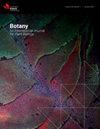墨西哥番茄和马铃薯一个多年生亲缘植物花蜜的延迟自受精和化学分析
IF 1
4区 生物学
Q3 PLANT SCIENCES
引用次数: 0
摘要
我们研究了墨西哥米却肯一种罕见的多年生植物大花茄科植物的花繁殖生物学和花蜜化学。在第1天,花为雌蕊状(柱头可接受,花药尚未呈现花粉);花闭了一夜。第2天清晨,花冠重新开放,雄蕊伸长到其早期长度的五倍,花药开裂;在第2天的大部分时间里,开裂的花药距离柱头保持约2毫米。第2天下午,花冠再次闭合,雄蕊座脱落,柱头上才能看到花粉。在第1天和第2天,原雌生殖和两性生殖可能分别促进异交。自主自花授粉发生在花冠寿命结束时,在没有授粉者的情况下可以产生果实和种子,但与人工自花授粉的果实相比,果实更轻,种子更少。使用亲水相互作用液相色谱法和电晕气溶胶检测法对花蜜样品中的碳水化合物进行分离和定量。在花蜜中,平均蔗糖浓度(0.482毫克/毫克花蜜)大约是葡萄糖(0.043毫克/毫克甘露)和果糖(0.095毫克/毫克蜂蜜)浓度的十到五倍。本文章由计算机程序翻译,如有差异,请以英文原文为准。
Delayed self-fertilization and chemical analysis of floral nectar of a perennial relative of the tomato and potato from Mexico
We studied the floral reproductive biology and nectar chemistry of Jaltomata grandiflora (Solanaceae), an apparently rare perennial of Michoacán, Mexico. During Day 1 flowers are pistillate (stigma receptive, anthers not yet presenting pollen); flowers close for the night. Early in the morning of Day 2 the corolla re-opens, stamens elongate to five times their earlier length, and anthers dehisce; the dehisced anthers remain about two mm from the stigma for much of Day 2. In the afternoon of Day 2 the corolla again closes, the corolla-androecium abscises, and only then can pollen be seen on the stigma. Protogyny and herkogamy likely promote outcrossing during Days 1 and 2, respectively. Autonomous self-pollination takes place at the end of the corolla’s life and allows fruit and seed production in the absence of pollinators but results in fruits that are lighter and contain fewer seeds than fruits resulting from manual self-pollinations. Carbohydrates from floral nectar samples were separated and quantified using hydrophilic interaction liquid chromatography coupled with corona charged aerosol detection. In nectar, mean sucrose concentration (0.482 mg/mg nectar), is about ten and five times higher than glucose (0.043 mg/mg nectar) and fructose (0.095 mg/mg nectar) concentrations.
求助全文
通过发布文献求助,成功后即可免费获取论文全文。
去求助
来源期刊

Botany
生物-植物科学
CiteScore
2.20
自引率
9.10%
发文量
48
期刊介绍:
Botany features comprehensive research articles and notes in all segments of plant sciences, including cell and molecular biology, ecology, mycology and plant-microbe interactions, phycology, physiology and biochemistry, structure and development, genetics, systematics, and phytogeography. It also publishes methods, commentary, and review articles on topics of current interest, contributed by internationally recognized scientists.
 求助内容:
求助内容: 应助结果提醒方式:
应助结果提醒方式:


